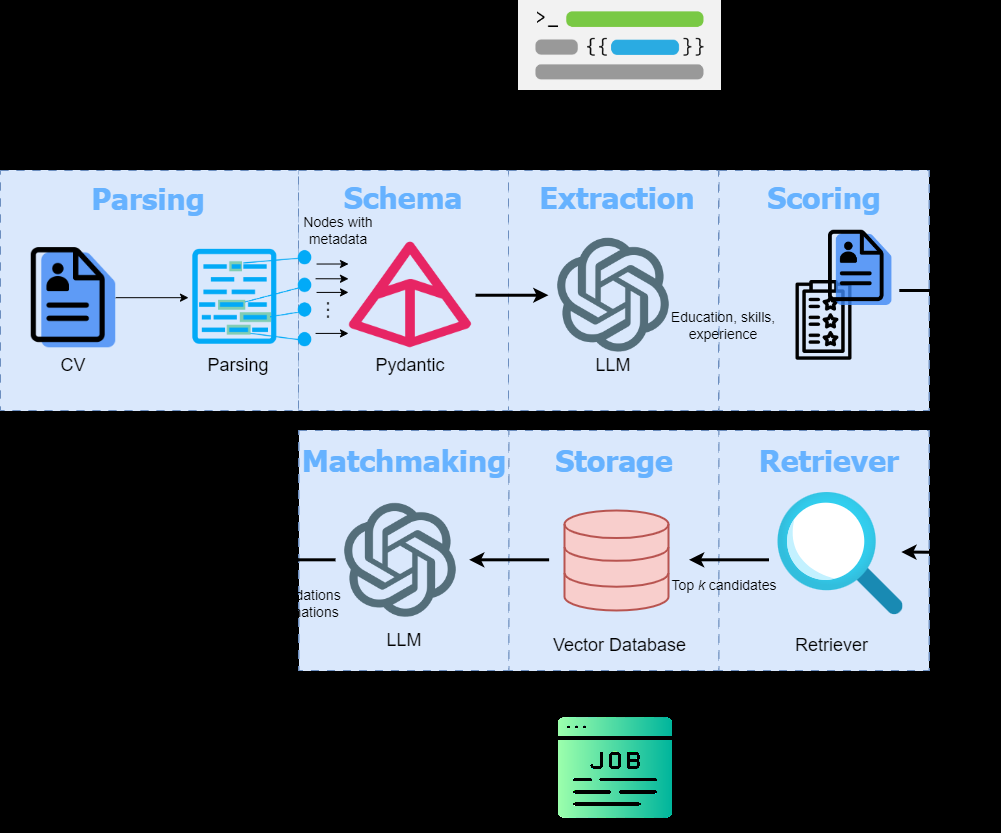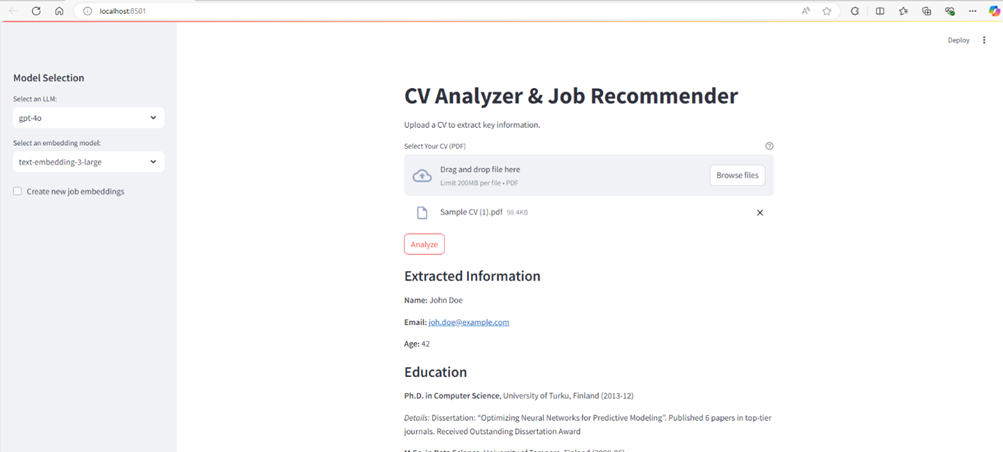AI-Powered Information Extraction and Matchmaking
This article explores using Large Language Models (LLMs) for information extraction from job seeker CVs and recommending suitable jobs. It leverages LlamaParse for document parsing and Pydantic for structured data extraction and validation, minimizing LLM hallucinations. The process involves: extracting key information (education, skills, experience), scoring skills based on their prominence in the CV, creating a job vector database, retrieving top job matches based on semantic similarity, and generating recommendations with explanations using an LLM.
A Streamlit application allows users to upload a CV (PDF), select LLMs (OpenAI's gpt-4o or open-source alternatives), and embedding models. The application then extracts the candidate's profile, computes skill scores (displayed as a star rating), and provides top job recommendations with explanations. The code uses OpenAI's API for the gpt-4o LLM and text-embedding-3-large embedding model, but offers flexibility to use open-source alternatives with a CUDA-enabled GPU.
The article details the Pydantic models for structured data extraction, showcasing their use in validating LLM output and ensuring data consistency. It explains the process of creating a job vector database from a curated JSON dataset (sample_jobs.json) and using cosine similarity to score skills based on their semantic relevance within the CV. The final job recommendations are generated using a Retrieval-Augmented Generation (RAG) approach, combining the extracted profile information with relevant job descriptions from the vector database.
The Streamlit application displays the extracted profile information (name, email, age, education, skills, experience) and the top job matches, including company details, job descriptions, location, employment type, salary range (if available), URL, and a brief explanation of the match. The skill scores are visually represented using a star rating system.
The article concludes by suggesting areas for improvement and expansion, including: improving the job database ingestion pipeline, expanding the profile information extracted from CVs, refining the skill-scoring method, extending the application to match job ads with candidate profiles, testing the application with diverse CV formats, and providing CV improvement and upskilling recommendations. The complete code is available on GitHub. The author encourages readers to clap, comment, and follow them on Medium and LinkedIn.


The above is the detailed content of AI-Powered Information Extraction and Matchmaking. For more information, please follow other related articles on the PHP Chinese website!

Hot AI Tools

Undresser.AI Undress
AI-powered app for creating realistic nude photos

AI Clothes Remover
Online AI tool for removing clothes from photos.

Undress AI Tool
Undress images for free

Clothoff.io
AI clothes remover

AI Hentai Generator
Generate AI Hentai for free.

Hot Article

Hot Tools

Notepad++7.3.1
Easy-to-use and free code editor

SublimeText3 Chinese version
Chinese version, very easy to use

Zend Studio 13.0.1
Powerful PHP integrated development environment

Dreamweaver CS6
Visual web development tools

SublimeText3 Mac version
God-level code editing software (SublimeText3)

Hot Topics
 1384
1384
 52
52
 I Tried Vibe Coding with Cursor AI and It's Amazing!
Mar 20, 2025 pm 03:34 PM
I Tried Vibe Coding with Cursor AI and It's Amazing!
Mar 20, 2025 pm 03:34 PM
Vibe coding is reshaping the world of software development by letting us create applications using natural language instead of endless lines of code. Inspired by visionaries like Andrej Karpathy, this innovative approach lets dev
 Top 5 GenAI Launches of February 2025: GPT-4.5, Grok-3 & More!
Mar 22, 2025 am 10:58 AM
Top 5 GenAI Launches of February 2025: GPT-4.5, Grok-3 & More!
Mar 22, 2025 am 10:58 AM
February 2025 has been yet another game-changing month for generative AI, bringing us some of the most anticipated model upgrades and groundbreaking new features. From xAI’s Grok 3 and Anthropic’s Claude 3.7 Sonnet, to OpenAI’s G
 How to Use YOLO v12 for Object Detection?
Mar 22, 2025 am 11:07 AM
How to Use YOLO v12 for Object Detection?
Mar 22, 2025 am 11:07 AM
YOLO (You Only Look Once) has been a leading real-time object detection framework, with each iteration improving upon the previous versions. The latest version YOLO v12 introduces advancements that significantly enhance accuracy
 Best AI Art Generators (Free & Paid) for Creative Projects
Apr 02, 2025 pm 06:10 PM
Best AI Art Generators (Free & Paid) for Creative Projects
Apr 02, 2025 pm 06:10 PM
The article reviews top AI art generators, discussing their features, suitability for creative projects, and value. It highlights Midjourney as the best value for professionals and recommends DALL-E 2 for high-quality, customizable art.
 Is ChatGPT 4 O available?
Mar 28, 2025 pm 05:29 PM
Is ChatGPT 4 O available?
Mar 28, 2025 pm 05:29 PM
ChatGPT 4 is currently available and widely used, demonstrating significant improvements in understanding context and generating coherent responses compared to its predecessors like ChatGPT 3.5. Future developments may include more personalized interactions and real-time data processing capabilities, further enhancing its potential for various applications.
 Which AI is better than ChatGPT?
Mar 18, 2025 pm 06:05 PM
Which AI is better than ChatGPT?
Mar 18, 2025 pm 06:05 PM
The article discusses AI models surpassing ChatGPT, like LaMDA, LLaMA, and Grok, highlighting their advantages in accuracy, understanding, and industry impact.(159 characters)
 How to Use Mistral OCR for Your Next RAG Model
Mar 21, 2025 am 11:11 AM
How to Use Mistral OCR for Your Next RAG Model
Mar 21, 2025 am 11:11 AM
Mistral OCR: Revolutionizing Retrieval-Augmented Generation with Multimodal Document Understanding Retrieval-Augmented Generation (RAG) systems have significantly advanced AI capabilities, enabling access to vast data stores for more informed respons
 Best AI Chatbots Compared (ChatGPT, Gemini, Claude & More)
Apr 02, 2025 pm 06:09 PM
Best AI Chatbots Compared (ChatGPT, Gemini, Claude & More)
Apr 02, 2025 pm 06:09 PM
The article compares top AI chatbots like ChatGPT, Gemini, and Claude, focusing on their unique features, customization options, and performance in natural language processing and reliability.




